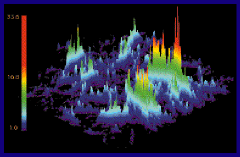R. Winn Hardin
LOS ANGELES -- A new imaging technique could lead to a better understanding of nonlinear relationships and fiber optic communication by studying fluids.
Physicist Steve Putterman at the University of California at Los Angeles and associates at the nearby Santa Barbara campus have created a way to quantitatively measure turbulence in ripple-wave formations.
Turbulence on the water's surface differs from normal ripple-wave motion in that it has a finite beginning and end and progresses into oblivion in a nonlinear fashion. Theories abound regarding the causes of turbulence, but today scientists literally grasp at shadows for a way to quantitatively test them.
Conventional means to measure ripple-wave heights, called shadowgraphs, involve shining a light upward from below a fluid body. A camera images the patterns formed on a diffusing plate above the liquid. Although simple in design, this method produces physical "catastrophes" -- the technical name for when a ray is diffracted by a sloped surface and crosses another light beam -- which make it ineffective for quantitative measurement.

Diffusing light photography yields true, 3-D surface maps of wave-ripple interactions. Turbulent structures appear as high-color peaks.
|
To avoid this, Putterman's group mixed a 0.04 percent suspension of polystyrene spheres with the water. The spheres cause the light to diffuse through the liquid, which elimates catastrophic ray crossings, providing high-resolution photos of steep slope surfaces. A camera images the patterns formed on a diffusing plate above the liquid, and differences in intensity indicate the water height.
Putterman said that this is only the beginning of an experiment that could take turbulence theory and his new diffusing light photography technique to new heights.
The sky's the limit
The researchers will meet with NASA and Canadian aerospace program officials to discuss when a more advanced version of Putterman's experiment will ride the space shuttle into Earth's orbit. Unbound by walls, the ripples will be able to infinitely interact in the zero gravity of space, allowing a "pure" investigation into the causes and life cycles of turbulent structures.
Other improvements could entail exchanging the xenon arc lamp light source for a monochrome source, shortening the 10-µs light pulse and using Fourier transform optics to watch the birth, life and death of turbulent structures in real time.